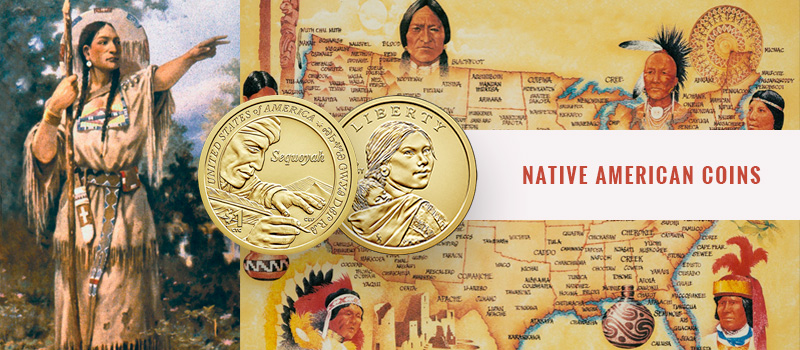Native American dollars

The Native American dollars or the more popularly known Sacagawea dollars have been minted from 2000 till now. These coins honor the Native Americans history and way of life. When the Europeans landed in the Americas in the 15th and 16th centuries, the Native Americans wouldnt have realized the extent to which their numbers would diminish in the next three centuries. The natives had a unique philosophy to everything, starting from their land, the river and their animals. The Spanish and later other Europeans who landed on their shores had a completely different view on land ownership and animal hunting. This huge cultural divide was in some ways detrimental to the natives.
Initially, some natives were friendly and had trade relations with the Europeans. They traded furs for the knives, axes and tools that the new comers brought with them. But most relations were uneasy and led to skirmishes as the natives lost their lands and their game. They were also not immune to the new diseases that the Europeans brought with them. By the early 19th century, the Native American population had come down to 2 million from an estimated 20 million in 16th century.
In the latter half of the 20th century, the United States government brought in many programs to revive the Native American community and tried to assuage their collective consciousness. One of the gestures was to release the Native American dollars to honor famous Native Americans.
Sacagawea dollar - 2000 to 2008
Based on the 1997 United States $1 coin act, the dollar design was to be changed in 2000. A Dollar design review committee was set up and around seventeen concepts were submitted, each honoring a woman or women. In 1998, the committee recommended Sacagawea design, the shoshone guide to the Lewis and Clark expedition after the Lousiana Purchase. Sacagawea was the squaw (Native American for woman or wife) ofToussaint Charbonneau who helped Lewis and Clark in navigating the terrain from North Dakota to the Pacific ocean and establishing relations with the native tribes.
The Native American dollar had an obverse design by Glenna Goodacre of Sacagawea with her infant son Jean Baptiste slung on the back. The reverse had a design of a soaring eagle designed by Thomas D. Rogers.
Reverse designs - 2009 to 2016
In 2007, a new Native American $1 Coin act specified that the Native American dollars will depict the contributions of the Indian tribes and individual Native Americans to the American history. From 2009, instead of the soaring eagle, a new design was released for the reverse while the Sacagawea design was retained for the obverse. The date, mintmark and 'E PLURIBUS UNUM' were moved to the edge. (More on coins with edge lettering here)
In 2009, the reverse had the design called 'Three Sisters Agriculture' by Mint sculptor-engraver Norman E. Nemeth depicting a Native American woman planting a field with corn, beans and squash. For 2010, the theme was the 'Great Tree of Peace' depicting the Hiawatha belt (representing the five nations) around five stone-tipped arrows.
The 2011 coin depicts the 'Wampanoag Treaty of 1621' where the Supreme Sachem Ousamequin and Plymouth Colony Governor John Carver are shown holding a ceremonial pipe. In the 2012 coin, the 'Trade routes of the 17th century' wasthe subject. It shows a Native American man and a horse with galloping horses in the background.
The 2013 Native American dollars depict the subject 'Treaty with the Lenape of 1778'. This was the first treaty between the U.S. government and a Native American tribe. The design shows a turkey, a howling wolf, and a turtlesymbols of the Lenape tribe. 'William Clarks compass' was the subject for the 2014 coin which shows a Native American man holding a ceremonial pipe while his wife is holding a plate ofprovisions that includes fish, corn, roots and gourds. Behind them is a stylized version of William Clark's compass showing North-West direction.
The 2015 coin depicts the 'Mohawk Ironworkers' - Kahnawake and Akwesasne Mohawk ironworkers who helped build New York's skycrapers. In 2016, the subject was the 'Code Talkers from WW1 and WW2'. Bi-lingual Native Americans like the Cherokee and Choctaw natives were employed as code-talkers, to pass secret information to different outposts in World War 1. In World War 2, the Navajos were employed by marines as the code-talkers in the Pacific Theater.
2017 Native American dollars - Sequoyah design
This year the Native American dollar celebrates 'Sequoyah' the inventor of the Cherokee syllabury. Sequoyah was a silver smith who worked with many whites. He wasimpressed with the 'talking leaves' that white men exchanged and knew they were exchanging information. After creating the syllabury using mainly latin letters, he taught it to his little daughter as the elders were sceptical. Slowly Sequoyah started demonstrating the usefulness of the syllabury to chiefs of the Western Cherokee. Soon Cherokees all over the nation started learning the syllabury and Sequoyah became a legend.
The 2017 Native American dollars' reverse features Sequoyah writing Sequoyah from Cherokee Nation in syllabary along the border of the design. It has the inscriptions UNITED STATES of AMERICA $1, and Sequoyah written in English.
Check out the Native American coin with us!
References
- https://en.wikipedia.org/wiki/Sacagawea_dollar
- https://en.wikipedia.org/wiki/Sacagawea
- https://en.wikipedia.org/wiki/Sequoyah
This entry was posted in General on February 01, 2017 by lavanya kannan

Leave a comment